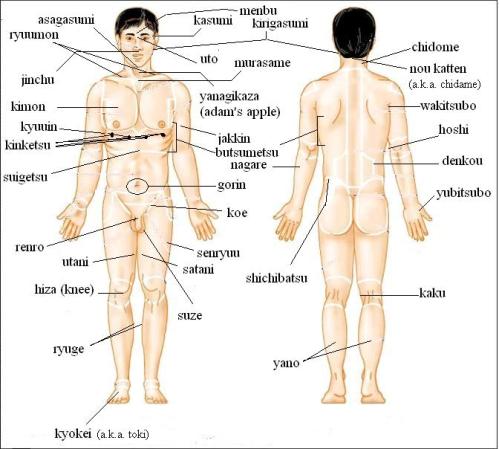One element of training that is frequently neglected is kyūsho targeting (i.e. attacking “pressure points.”) One reason for this is that it’s challenging to focus attention on such a fine level of granularity when there seem to be more pressing issues to occupy one’s mind. Another reason is that it’s easy to become jaded with this subject when one finds that in randori (free sparring), rarely do attempts at accurate targeting work out cleanly. Just look at competitive fights, be they boxing, MMA, or muay thai. All fighters know where “the button” is that will produce a knock-out, but relatively few fights are decided by knockout. That’s because when an opponent is moving, keeping his guard up, and delivering his own strikes, hitting a specific target is no easy task.
There are a few good reasons to pay attention to this subject nonetheless. First, one may attack these spots either while grappling or while one has momentarily pinned the opponent. In such instants, one may have the relative “leisure” time to attack kyūsho. Second, if one practices accurately target and ingrains it, one increases the likelihood of making it work. Yes, one may well miss in the chaos of exchanging blows, but if you increase your likelihood of hitting the nail on the head, you gain an advantage. Third, the difference between striking the kyūsho and striking NEAR the kyūsho can be tremendous. Hitting on the kyūsho can numb limbs, cause muscle groups to temporarily fail, or even cause loss of consciousness.
I’ve included a map, but the names are not so important. Names may vary from one school to the next. The map above uses names / locations from the maps of two different schools, Takagi Yōshin ryū jujutsu and Kotō ryū Koppōjutsu. Different schools have different rationales and approaches, and that determines what kyūsho each is likely to target. What is important is not looking at maps and memorizing names. Rather one should practice finding the points on one’s own body. Applying thumb pressure, one should be able to tell a considerable difference between when one is on the mark and when on is off.
If one is really into learning about kyūsho, one can learn a great deal from writings on Traditional Chinese Medicine (TCM) acupressure. Generally, these points can be found on TCM meridian maps. On such maps, points will have an alpha-numeric designation. The one to three letter code will tell which channel the point is located on, and the number tells which point along the channel it is. For example, the point P-6 (Inner Gate) is a point on the inside of the wrist that can be targeted to weaken an attacking arm.
The 12 main channels are:
LU – Lung
LI – Large Intestine
SP – Spleen
H – Heart
SI – Small Intestine
UB – Urinary Bladder
KID – Kidney
P – Pericardium
SJ – Triple Heater
GB – Gall Bladder
L – Liver
There are also eight extraordinary channels: DU – Governing channel, REN – Conception channel, Chong Mai (vitality) channel, Dai Mai (belt) channel, Yang Qiao (Yang connecting) channel, Yin Qiao (Yin connecting) channel, Yang Wei (Yang regulating) channel, and Yin Wei (Yin regulating) channel.


Leave a comment